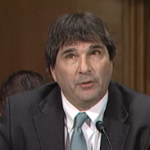By Ivy Schmerken, FlexTrade
Senators conducting a hearing on U.S. equity market structure earlier this month vented their frustrations at the slow pace of regulatory change in equity market structure reforms.
At the March 3 hearing, lawmakers repeatedly cited delays in developing the consolidated audit trail, or CAT system, for market-wide surveillance, questioning to what extent progress has been made.
“It’s beyond frustrating that six years after the Flash Crash we still haven’t built the CAT,” stated Sen. Michael Crapo (R-Idaho), who is a ranking member of the Banking, Housing and Urban Affairs Subcommittee on securities, insurance and investment of the Committee on Banking, Housing and Urban Affairs. They also cited a lack of progress on bond market transparency whereby brokers are charging markups and markdowns on retail bond trades.
Despite some delays, SEC and FINRA officials conveyed that a number of market structure initiatives are in progress and could come to fruition in 2016 before the term of the current Obama administration ends.
Stephen Luparello, Director of the Division of Trading and Markets at the Securities and Exchange Commission, assured lawmakers that CAT was a priority, and that the commission was about a month away from publishing a CAT plan.
He also said the SEC is working on an institutional order routing transparency rule known as Institutional 606, which will give institutions more insight into their brokers’ order routing decisions, and an anti-disruptive trading rule to address aggressive, destabilizing computerized strategies. But lawmakers urged regulators to move forward with a pilot on maker-taker rebates and access fees, a practice that critics say has led to convoluted fee structures and tiered pricing at exchanges.
A recent study by Royal Bank of Canada found there were 839 fee schedules across 12 exchanges. The fees are so convoluted that they are even confusing for traders at brokerage houses, reported The New York Times.
“If you’ve got 839 fee schedules and over 3,700 different variables all trying to create bespoke products, push fees and rebates to individual brokers, that’s not on the up and up,” said Sen. Mark R. Warner, D-VA, commenting on the study at the hearing. Warner suggested that access fees and rebates are adding a level of complexity that even for Wall Street is over the top. “It is clearly driving commissions, fees and rebates in a way that isn’t transparent,” he added. “We really need to know when the full committee is going to act. And when this pilot is going to take place,” insisted Warner.
According to the SEC’s Stephen Luparello, a subcommittee of the SEC’s Equity Market Structure Advisory Committee (EMSAC) is examining the issue and is expected to make a recommendation to the full committee at their next meeting on April 26.
While senators asked if the pilot could happen in the summer, Luparello stated that, “a commission-mandated maker-taker pilot would take a few months after that.” But he told lawmakers that a recommendation by the EMSAC would find a “ready audience” with the SEC staff, but the staff would still need to make a recommendation to the Commission.
Tick Pilot About to Fly
One of the unintended consequences of moving forward with the maker-taker pilot is that the industry is about to begin the tick data pilot for small- and mid-cap stocks. The deadline for the tick pilot has slipped by five months to give firms extra time for the technological changes associated with data collection. Based on the new timetable, the pre-data collection phase of the tick pilot is set for April 4, while the full pilot kicks off on Oct. 3, 2016.
Warner faulted exchanges for trying to design the tick pilot in a way that promotes their own commercial interests rather than increasing liquidity in small cap stocks, alluding to the Trade-At provision. He indicated it was his hope and expectation that the pilot would take place this year. In response, Luparello said the SEC is going to get it done in October, noting that it already has filings from two of the markets that define some of the provisions. “We have the data gathering part of the rule making done and I think were in good shape to move forward.”
As for maker-taker, Luparello said that while there are concerns with other pilots that could create complexity in the market, the maker-taker pilot could be done very simply.
Richard Ketchum, chairman and CEO of FINRA, threw his support behind the maker-taker pilot. “It is something that should be done from the standpoint of data,” said Ketchum testifying at the hearing. “I think this is absolutely the right time to make changes around equity pricing,” he said.
One rationale for undertaking the maker-taker pilot on top of the tick pilot is that it’s much simpler and narrower in scope. “You could simply pick 100 different equities, put 50 in the control batch and 50 in a non-control batch and flick a switch,” said Warner. By contrast, the tick size pilot will consist of a control group of approximately 1,400 pilot securities, and three test groups with 400 pilot securities in each selected by a stratified random sampling process. In addition, the third group contains a Trade-At provision, which some exchanges requested to prevent trading centers, such as dark pools, from matching protected quotations without offering a better price.
Is Conducting Two Pilots a Good Idea?
But does the industry have the resources to conduct more than one pilot at a time? In a follow up call held by the Securities Traders Association to discuss the hearing, Eric Swanson, General Counsel & Secretary at BATS Global Markets, said he was “a little surprised by the momentum behind the implementation of this access fee pilot in securities that are outside the scope of the tick pilot. By the same token, I would have thought that running two pilots on market structure might be a bit of a heavy lift for folks in the industry,” said Swanson. On the other hand, the industry is attuned to how to affect access fee changes, he added.
However, third-party vendors will potentially need to support both pilots at the same time. “They don’t take into account the cost to the industry,” commented Jamie Benincasa, Senior Vice President at FlexTrade Systems. Vendors need to keep up with all the new compliance rules, he said. “We’re required for the broker-dealer firms that use us as an OMS to comply with regulations and rule changes. We’ll have to commit resources in order to accommodate these changes. Whereas, if the pilot gets thrown away, there’s no way for a vendor to recoup the cost,” said Benincasa.
Meanwhile, it remains to be seen how fast the industry can approve and implement a pilot on maker-taker.
Not So Fast
Jim Toes, president and CEO of the STA, said it’s too early in the process to know what will result from the EMSAC meeting. “It is still six weeks between now and when the committee meets again.”
If the EMSAC subcommittee recommends the maker-taker fee pilot, it must go to the full EMSAC committee for their approval. If the full committee approves the recommendation then it will go to the SEC. Once the Commission approves the pilot, it would need to publish the plan for public comment.
Toes notes that the tick pilot was first mentioned in 2011 and it’s now being implemented in 2016.
Even though the outcome of the EMSAC subcommittee report is unclear at this point, every one at the hearing seemed to like the idea. The SEC directed the EMSAC to focus on constructing a marker-taker pilot. “That’s an important first, tangible deliverable and it is absolutely the right priority,” said the SEC’s Luparello. Still, before jumping into a second pilot, firms should know all of the details.


















